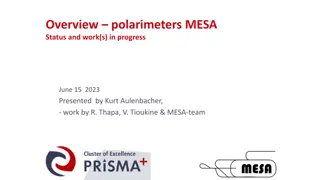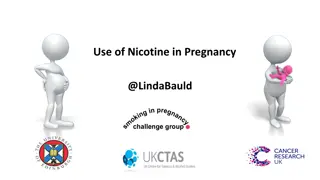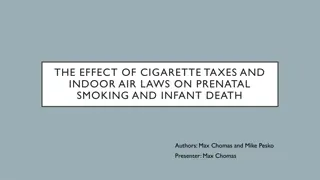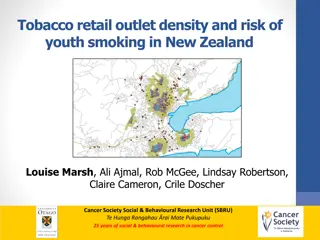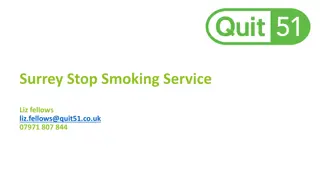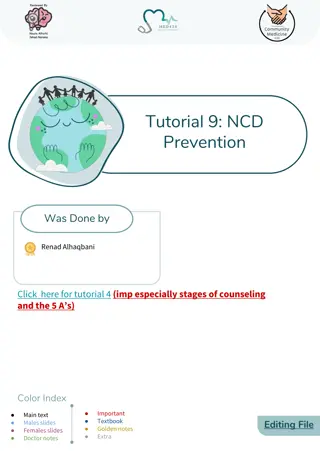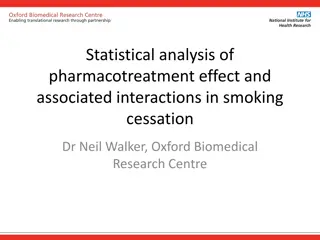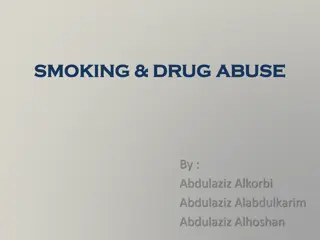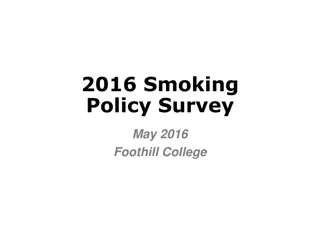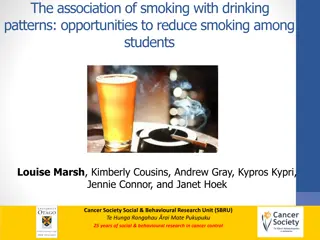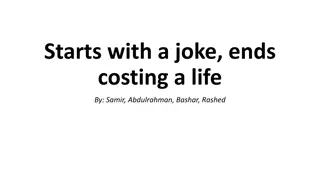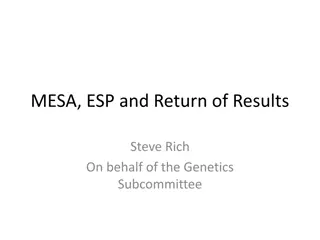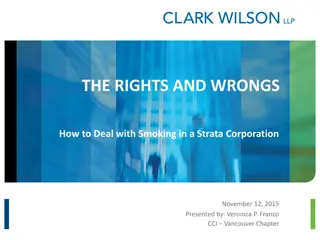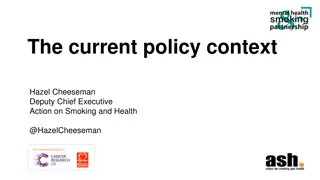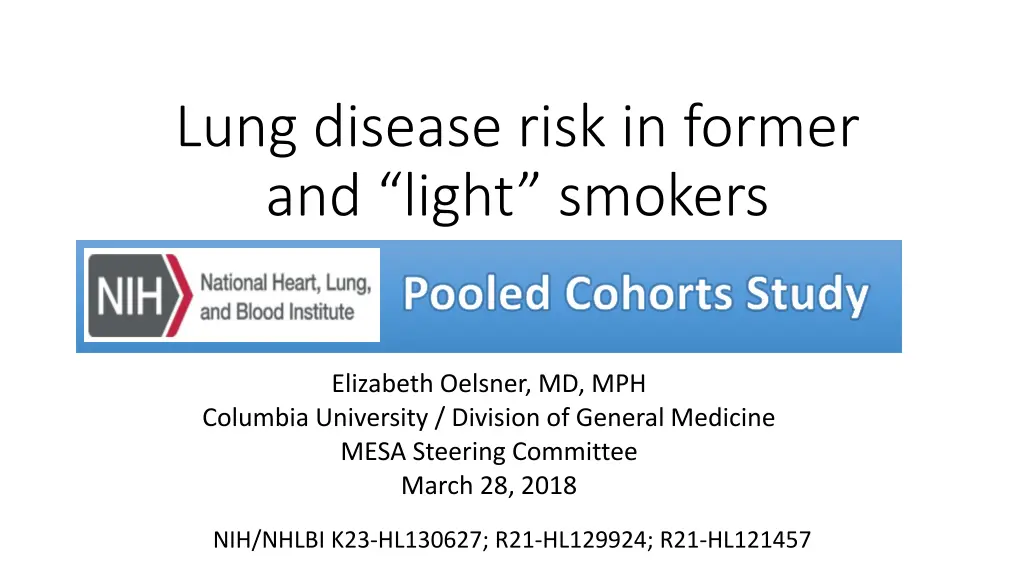
Lung Disease Risk in Former and Light Smokers Study Findings
Explore the risks of lung disease in former and light smokers based on a pooled cohorts study. Understand the impact of smoking on lung function decline and the development of COPD. Gain insights into smoking-related diseases and behaviors in the US, including smoking-related deaths and prevalence rates. Discover knowledge gaps regarding respiratory risks in former and light smokers.
Download Presentation

Please find below an Image/Link to download the presentation.
The content on the website is provided AS IS for your information and personal use only. It may not be sold, licensed, or shared on other websites without obtaining consent from the author. If you encounter any issues during the download, it is possible that the publisher has removed the file from their server.
You are allowed to download the files provided on this website for personal or commercial use, subject to the condition that they are used lawfully. All files are the property of their respective owners.
The content on the website is provided AS IS for your information and personal use only. It may not be sold, licensed, or shared on other websites without obtaining consent from the author.
E N D
Presentation Transcript
Lung disease risk in former and light smokers Pooled Cohorts Study Elizabeth Oelsner, MD, MPH Columbia University / Division of General Medicine MESA Steering Committee March 28, 2018 NIH/NHLBI K23-HL130627; R21-HL129924; R21-HL121457
Smoking-related diseases and behaviors in the US Smoking-related deaths, 2005-2009 CDC Factsheets. National Health Interview Survey, US, 2005 2014
Smoking-related diseases and behaviors in the US Smoking-related deaths, 2005-2009 Percent of adults currently smoking, 2005-2014 CDC Factsheets. National Health Interview Survey, US, 2005 2014
Smoking-related diseases and behaviors in the US Smoking-related deaths, 2005-2009 Percent of adults currently smoking, 2005-2014 Cigarettes smoked per day in current smokers, 2005-2014 1-9 CPD 30+ CPD CDC Factsheets. National Health Interview Survey, US, 2005 2014
Smoking-related diseases and behaviors in the US Smoking-related deaths, 2005-2009 Percent of adults currently smoking, 2005-2014 Cigarettes smoked per day in current smokers, 2005-2014 1-9 CPD 30+ CPD Knowledge gaps regarding respiratory risks in former & light smokers CDC Factsheets. National Health Interview Survey, US, 2005 2014
Smoking and lung function decline FEV1 peaks in early adulthood and then declines Smoking accelerates FEV1 decline Accelerated FEV1 decline is recognized as a cause of COPD (FEV1/FVC <0.70) A susceptible smoker who stops smoking will not recover lost FEV1, but the subsequent rate of loss of FEV1 will revert to normal Fletcher & Peto 1977 Neas & Schwartz, Am J Epidemiol 1998. McGeachie, NEJM 2016. Lange P, NEJM 2015. Fletcher & Peto, Br Med J 1977. Anthoniesen, AJRCCM 2002. Lee & Fry, BMC Med 2010.
Smoking and lung function decline FEV1 peaks in early adulthood and then declines Smoking accelerates FEV1 decline Accelerated FEV1 decline is recognized as a cause of COPD (FEV1/FVC <0.70) A susceptible smoker who stops smoking will not recover lost FEV1, but the subsequent rate of loss of FEV1 will revert to normal Fletcher & Peto 1977 Never Neas & Schwartz, Am J Epidemiol 1998. McGeachie, NEJM 2016. Lange P, NEJM 2015. Fletcher & Peto, Br Med J 1977. Anthoniesen, AJRCCM 2002. Lee & Fry, BMC Med 2010.
Smoking and lung function decline FEV1 peaks in early adulthood and then declines Smoking accelerates FEV1 decline Accelerated FEV1 decline is recognized as a cause of COPD (FEV1/FVC <0.70) A susceptible smoker who stops smoking will not recover lost FEV1, but the subsequent rate of loss of FEV1 will revert to normal Fletcher & Peto 1977 Never Current Neas & Schwartz, Am J Epidemiol 1998. McGeachie, NEJM 2016. Lange P, NEJM 2015. Fletcher & Peto, Br Med J 1977. Anthoniesen, AJRCCM 2002. Lee & Fry, BMC Med 2010.
Smoking and lung function decline FEV1 peaks in early adulthood and then declines Smoking accelerates FEV1 decline Accelerated FEV1 decline is recognized as a cause of COPD (FEV1/FVC <0.70) A susceptible smoker who stops smoking will not recover lost FEV1, but the subsequent rate of loss of FEV1 will revert to normal Fletcher & Peto 1977 Never Former Current Neas & Schwartz, Am J Epidemiol 1998. McGeachie, NEJM 2016. Lange P, NEJM 2015. Fletcher & Peto, Br Med J 1977. Anthoniesen, AJRCCM 2002. Lee & Fry, BMC Med 2010.
Smoking and lung function decline FEV1 peaks in early adulthood and then declines Smoking accelerates FEV1 decline Accelerated FEV1 decline is recognized as a cause of COPD (FEV1/FVC <0.70) A susceptible smoker who stops smoking will not recover lost FEV1, but the subsequent rate of loss of FEV1 will revert to normal Fletcher & Peto 1977 Never Former Current Compared to never smokers, former smokers hypothesized to have lower FEV1 (low intercept) but same FEV1 decline (normal slope) Neas & Schwartz, Am J Epidemiol 1998. McGeachie, NEJM 2016. Lange P, NEJM 2015. Fletcher & Peto, Br Med J 1977. Anthoniesen, AJRCCM 2002. Lee & Fry, BMC Med 2010.
Smoking cessation and lung function decline Marked improvement in FEV1 decline was demonstrated in a randomized controlled trial of a smoking cessation intervention The Lung Health Study included smokers without clinical lung disease Anthoniesen, AJRCCM 2002. Lee & Fry, BMC Med 2010.
Smoking cessation and lung function decline Marked improvement in FEV1 decline was demonstrated in a randomized controlled trial of a smoking cessation intervention The Lung Health Study included smokers without clinical lung disease Former Anthoniesen, AJRCCM 2002. Lee & Fry, BMC Med 2010.
Smoking cessation and lung function decline Marked improvement in FEV1 decline was demonstrated in a randomized controlled trial of a smoking cessation intervention The Lung Health Study included smokers without clinical lung disease Former Current Anthoniesen, AJRCCM 2002. Lee & Fry, BMC Med 2010.
Smoking cessation and lung function decline Marked improvement in FEV1 decline was demonstrated in a randomized controlled trial of a smoking cessation intervention The Lung Health Study included smokers without clinical lung disease Former Current Comparisons of lung function decline in former smokers versus never smokers are limited and inconsistent Anthoniesen, AJRCCM 2002. Lee & Fry, BMC Med 2010.
Mechanisms of lung function decline Mechanisms of lung function decline that show sustained dysregulation after smoking cessation Emphysema with intermittent smoking Inflammation Yes Continuous cigarette smoke Intermittent cigarette smoke Immune modulation Yes Control Epigenetics Yes Airway hyper-responsiveness Yes Mucous hypersecretion Yes Emphysema Yes Biological and physiological evidence suggest that accelerated lung function decline should be anticipated in former smokers, and that there is no safe level of cigarette exposure Verbanck S, AJRCCM 2006. Bhatt S, AJRCCM 2017. Oelsner, Thorax 2017. Wang G, PLoS One 2015. Kamehama N, ARJCMB 2018.
Aims In a general population-based sample of adults with preserved lung function and without clinical lung disease, we aimed to test for differences in lung function decline according to smoking status and intensity
NHLBI Pooled Cohorts Study 9 cohorts 65,251 participants 653,380 person-years of follow-up for respiratory mortality ARIC JHS CARDIA N=5,115c MESA N=7,071d CHS N=5,888 FHS-O N=5,124 HABC N=3,075 HCHS N=16,415 SHS N=3,516 Year N=15,792a N=5,306b 1971 1972 1973 1974 1975 1976 1977 1978 1979 1980 1981 1982 1983 1984 1985 1986 1987 1988 1989 1990 1991 1992 1993 1994 1995 1996 1997 1998 1999 2000 2001 2002 2003 2004 2005 2006 2007 2008 2009 2010 2011 2012 2013 2014 2015 Exam 1 Exam 2 Exam 3 Year 0 Year 2 Visit 1 Exam 4 Year 2 Year 3 Year 4 Year 5 Phase 1 Year 5 Visit 2 Year 7 Exam 5 Year 6 Visit 3 Phase 2 Year 7 Year 8 Year 9 Year 10 Year 11 Year 10 Exam 6 Visit 4 Exam 1 Exam 2 Exam 3 Exam 4 Exam 5 Exam 6 Exam 7 Exam 8 Exam 9 Exam 10 Exam 11 Exam 12 Exam 13 Exam 14 Exam 15 Exam 16 Phase 3 Exam 7 JHS Exam 1 Year 15 Exam 1 ARIC recruits (N=1,626 JHS-Only recruits (N=3,680) Phase 4 Exam 2 Exam 3 Year 20 Year 18 Exam 2 Exam 8 Exam 4 Phase 5 Exam 1 Year 25 Exam 5 Non-spiro exam Exam 3 Visit 5 Exam 9 Exam 2 Phase 6 Spiro exam a 424 gave restricted consent b Includes 1,626 participants recruited from ARIC c Withdrawal of consent by one participant d MESA + 257 new recruits into the MESA Air Pollution Study Visit with Spirometry Oelsner et al, Am J Epidemiol (technical review).
Longitudinal lung function data FEV1 (mL) versus age Pre-bronchodilator spirometry Quality controlled according to 2005 ATS/ERS standards Percent predicted FEV1 and FVC calculated via NHANES III equations Airflow limitation defined by FEV1/FVC < lower limit of normal (LLN) Restrictive spirometry defined by FEV1/FVC>LLN and FVC<LLN 105,700 valid FEV1 observations 59,508 participants Oelsner et al, Am J Epidemiol (technical review). Hankinson, AJRCCM 1999.
Selection of study sub-sample Inclusion criteria: 2+ valid spirometry exams Exclusion criteria: Prevalent clinical asthma, COPD, emphysema, or chronic bronchitis (prior MD diagnosis and/or inhaler use) Initial spirometry with airflow limitation or restrictive pattern Baseline exam within 2 years of reported quit date Inconsistent smoking status not conforming to one of four patterns: Never-smokers Former-smokers Quitting smokers (current former smoker) Sustained current smokers
Variables Smoking status and intensity Mainly self-reported, with biochemical verification in a subset Smoking status, time-variant Never = <100 lifetime cigarettes Current = within past 30 days Self-reported pack-years at baseline Self-reported time-variant cigarettes per day
Variables Smoking status and intensity Mainly self-reported, with biochemical verification in a subset Smoking status, time-variant Never = <100 lifetime cigarettes Current = within past 30 days Self-reported pack-years at baseline Self-reported time-variant cigarettes per day Decline in lung function Pre-bronchodilator spirometry Annualized rate of decline in: FEV1 FVC FEV1/FVC Incident airflow limitation Incident restrictive spirometry
Statistical analyses Never smokers used as reference group Mixed models for lung function decline Cohort-specific unstructured covariance matrix Adjustment for time-varying age, age2, smoking, height2; and time- invariant source cohort, gender, race, baseline age (centered), birth- year (centered), site, and educational attainment Multiplicative interactions with age for all time-invariant covariates Effect estimate for smoking*age interpreted as the association with annualized lung function decline Cox proportional hazards models for incident airflow limitation; similarly adjusted, additionally including baseline FEV1 and FVC Sensitivity analyses (stratification; multiple imputation)
CONSORT diagram Only one spirometry exam attempted HCHS/SOL (n=16,415) JHS (n=3,680) SHS (n=3,516) Not selected for spirometry in MESA (n=2,331) Declined spirometry (n=3,408) NHLBI Pooled Cohorts Study (n=65,251) Eligible/selected for 2+ spirometry exams (n=35,901) <2 valid spirometry exams (n=9,800) 2+ valid spirometry exams (n=26,101) Airflow limitation (n=3,705) Restrictive pattern (n=1,453) Preserved lung function (n=20,943) Clinical asthma (n=902) Clinical COPD (n=805) Without prevalent clinical lung disease (n=19,236) Inconsistent smoking status (n=2,532) Quit within 2 years of baseline (n=120) Missing covariate data (n=372) Final sub-sample (n=16,212)
Baseline characteristics Never smokers Former smokers Quitting smokers Current smokers Total No. (%) 8,179 (50%) 4,973 (31%) 1,636 (10%) 1,424 (9%) 16,212 Cohort (%) ARIC 41% 54% 42% 49% 45% CARDIA 22% 4% 19% 36% 17% CHS 10% 15% 4% 3% 11% FHS 11% 6% 29% 7% 11% Health ABC 7% 11% 2% 2% 7% MESA 9% 10% 3% 3% 8% Age, years 52 60 45 49 53 Male (%) 33% 58% 46% 48% 43% Race/ethnicity (%) White 69% 80% 75% 55% 71% Black 27% 17% 24% 44% 25% Other 5% 3% 2% 1% 4%
Baseline smoking and lung function Never smokers Former smokers Quitting smokers Current smokers Total Smoking, median 15 Pack-years 14 18 20 20 Cigarettes/day 0 15 20 18 Age at smoking initiation 18 18 17 39 Age at quitting 39 Lung function, mean FEV1 percent-predicted 99.8 100.8 100.0 97.0 96.5 FVC percent-predicted 100.6 100.9 100.9 99.3 99.1 Baseline FEV1/FVC 77.9 78.9 76.1 77.4 78.4 No. exams, median (IQR) 2 (2, 3) 3 (2, 4) 2 (2, 3) 3 (2, 4) 2 (2, 3) Years of spirometry follow-up, median (IQR) 7 (3, 20) 9 (3, 20) 6 (3, 16) 14 (4, 21) 4 (3, 14)
Unadjusted comparisons Never smokers -35.0 Former smokers -43.1 Quitting smokers -38.4 Current smokers -41.6 Delta FEV1 (mL/year) -.83 -1.81 -2.93 -5.62 Delta ppFEV1 (%/10-years) 247 (26) 237 (48) 151 (66) 155 (120) Incident airflow limitation, No. (IDR) Changes in lung function defined as (first value last value) / (first age last age). Incidence density rates (IDRs) defined per 10,000 person-years of observation. Mean differences versus never-smokers all statistically significant (P<.01). In unadjusted data, ever smokers demonstrate significantly greater FEV1 decline versus never smokers, and greater incidence of airflow limitation.
Decline in lung function Former smoking vs never smoking Current smoking vs never smoking Change in lung function Effect estimate 95% CI P-value Effect estimate 95% CI P-value FEV1, mL/year -1.71 -2.26, -1.16 <.0001 -2.92 -3.62, -2.22 <.0001 FVC, ml/year -1.78 -2.46, -1.10 <.0001 -2.13 -2.99, -1.27 <.0001 FEV1/FVC, %/year -.022 -.030, -.013 <.0001 -.052 -.063, -.041 <.0001 Mixed model with cohort-specific unstructured covariance matrix. Adjustment for time-varying age, age2, smoking, height2; and time- invariant source cohort, gender, race, baseline age (centered), birth-year (centered), site, and educational attainment. Interactions with age included for all time-invariant covariates. Effect estimate for smoking*age interpreted as the association with annualized lung function decline. Average FEV1 decline -33.7 mL/year. Average FVC decline -36.8 mL/year. Average FEV1/FVC decline -.185 %/year.
Decline in lung function Former smoking vs never smoking Current smoking vs never smoking Change in lung function Effect estimate 95% CI P-value Effect estimate 95% CI P-value FEV1, mL/year -1.71 -5% -2.26, -1.16 <.0001 -2.92 -9% -3.62, -2.22 <.0001 FVC, ml/year -1.78 -5% -2.46, -1.10 <.0001 -2.13 -6% -2.99, -1.27 <.0001 FEV1/FVC, %/year -.022 -12% -.030, -.013 <.0001 -.052 -28% -.063, -.041 <.0001 Mixed model with cohort-specific unstructured covariance matrix. Adjustment for time-varying age, age2, smoking, height2; and time- invariant source cohort, gender, race, baseline age (centered), birth-year (centered), site, and educational attainment. Interactions with age included for all time-invariant covariates. Effect estimate for smoking*age interpreted as the association with annualized lung function decline. Average FEV1 decline -33.7 mL/year. Average FVC decline -36.8 mL/year. Average FEV1/FVC decline -.185 %/year. Former smoking status was independently associated with accelerated decline in FEV1, FVC, and FEV1/FVC, with effect estimates approximately 50% of those for current smoking.
Incident airflow limitation Former smoker versus never smoker 95% CI Quitting smoker versus never smoker 95% CI Sustained smoker versus never smoker 95% CI Model HR P HR P HR Main model 1.46 1.21, 1.76 <.0001 2.80 2.25, 3.48 <.0001 4.13 3.33, 5.12 <.0001 + Baseline spirometry 1.25 1.04, 1.52 .020 1.81 1.46, 2.26 <.0001 2.46 1.98, 3.05 <.0001 Cox proportional hazards model with cohort as a stratum term. Adjustment for baseline age, age2, smoking, height2, gender, race, baseline age (centered), birth-year (centered), site, and educational attainment. Former smoking status was also associated with incident airflow limitation, independent of initial spirometry. No significant associations were found for restrictive spirometry.
Pack-year history Never smokers Former smokers Current smokers Even <10 pack-years of smoking was associated with accelerated lung function decline in both former and current smokers FEV1 (mL/year) Ref <10 pack-years -0.91 -2.26 10-20 pack-years -1.26 -4.87 -7.23 20+ pack-years -1.03 FVC (mL/year) Ref <10 pack-years -1.18 -1.64 10-20 pack-years -1.21 -4.17 20+ pack-years -1.68 -2.15 Mixed model with cohort-specific unstructured covariance matrix. Adjustment for time-varying age, age2, smoking exposure category, height2; and time-invariant source cohort, gender, race, baseline age (centered), birth-year (centered), site, and educational attainment. Statistically significant (P<.05) unless noted in italics. FEV1/FVC (percent) Ref <10 pack-years -.006 -.029 10-20 pack-years -.021 -.066 20+ pack-years -.022 -.165
Current cigarettes per day (CPD) Never smokers Ref Former Smokers -1.68 <3 CPD 3-20 CPD 20-30 CPD 30+ CPD FEV1 (mL/year) -2.56 -2.57 -3.33 -4.66 FVC (mL/year) Ref -1.76 -2.57 -1.73 -2.60 -2.40 FEV1/FVC (%/year) Ref -.022 -.029 -.050 -.055 -.087 Mixed model with cohort-specific unstructured covariance matrix. Adjustment for time-varying age, age2, smoking exposure category, height2; and time-invariant source cohort, gender, race, baseline age (centered), birth-year (centered), site, and educational attainment. Interactions with age included for all time-invariant covariates. Effect estimate for (smoking exposure category)*age interpreted as the association with annualized lung function decline. All comparisons statistically significant (P<.001). Current smoking, even <3 cigarettes/day, associated with substantially greater lung function decline compared to both never and former smoking
FEV1 decline and smoking status, stratified by sex and race/ethnicity Former Current N Main effect Former smoking consistently associated with accelerated FEV1 decline regardless of sex or race/ethnic group. Men Women White Black Change in FEV1/year, mL Effect estimate is the coefficient for age*smoking status. Fully stratified analyses. Mixed models with cohort-specific covariance matrix. Adjusted for age, smoking-status, height2, study, gender, race. Interactions with age modeled for smoking status and all time-invariant factors.
FEV1 decline and smoking status, stratified by by age, birth, and study cohort N Former Current N Change in FEV1/year, mL Change in FEV1/year, mL Effect estimate is the coefficient for age*smoking. Fully stratified analyses. Mixed models with cohort-specific covariance matrix. Adjusted for age, smoking-status, height2, study, gender, race. Interactions with age modeled for smoking status and all time-invariant factors. More variability in estimates among older participants and cohorts.
Multiple imputation conditional on vital status Former Smoking vs Never Smoking Current Smoking vs Never Smoking -1 -1 -2 -2 Imputation of missing lung function follow-up Censoring of imputed lung function if deceased -3 -3 -4 -4 -5 -5 -6 -6 -7 -7 Original Data Full Censored Imputation Full Censored Imputation Original Data Imputation Imputation No exclusions for spirometry QC, baseline CLD, or smoking pattern. Excludes ARIC exams 4 and 5 and CHS year 18. Model-based estimates from a mixed model with cohort-specific covariance matrix adjusted for time-varying age, height2, smoking status; birth year, study, sex, race/ethnicity, education, site; interactions with age included for all covariates. Original data, N=87,310 observations. Fully imputed data, N= 10,957,500 observations. Conditional imputation, N= 10,168,600 observations. Similar results obtained using multiple imputation approach conditional on vital status.
Limitations Selection biases Similar trends in all age groups and cohorts Robust to multiple imputation approach No data on cigarette type or composition (e.g., menthol) Heterogeneity of susceptibility (latent variables) Measurement error Limited number of observations per individual
Conclusions Years after quitting, former smokers demonstrate accelerated lung function decline compared to never-smokers Smoking-related lung function loss is apparent even with light smoking These findings are consistent with biological and physiological models demonstrating incomplete reversibility and nonlinearity of smoking s effects on the lungs
NHLBI Pooled Cohorts Study George O Connor Josee Dupuis Columbia R Graham Barr Pallavi Balte Joe Schwartz Andrew Moran Yiyi Zhang Mike Cuttica Ravi Kalhan David Jacobs Lewis Smith Aaron Folsom Alanna Morrison David Couper Laura Loehr Dick Kronmal Russ Tracy Bruce Psaty Paolo Chaves Stephanie London Alex Reiner Funding NIH/NHLBI K23-HL130627 R21-HL129924 R21-HL121457 Ann Newman Sachin Yende Jason Sanders Pat Cassano Jiayi Xu Joseph Schwartz Andrew Moran Michael Tsai Yiyi Zhang Paul Enright Ani Manichaikul
Unadjusted comparisons vs never-smokers Never smokers Former smokers Quitting smokers Current smokers Change in lung function -35.0 -43.1 -38.4 -41.6 FEV1 (mL/year) -39.4 -51.7 -40.1 -39.3 FVC (mL/year) -.12 -.10 -.19 -.31 FEV1/FVC (%/year) Change in percent-predicted lung function -.083 -.181 -.293 -.562 ppFEV1 (%/year) -.183 -.316 -.284 -.443 ppFVC (%/year) Incident spirometric abnormalities, No. (IDR) Airflow limitation 247 (25.9) 237 (47.6) 151 (66.4) 155 (119.5) 389 (40.8) 237 (47.6) 95 (34.7) 81 (75.2) Restrictive pattern Changes in lung function defined as (first value last value) / (first age last age). Incidence density rates (IDRs) defined per 10,000 person- years of observation. Mean differences versus never-smokers statistically significant (P<.01) for all smoking groups unless noted in italics. In unadjusted data, former smokers demonstrate significantly greater lung function decline versus never smokers, and greater incidence of airflow limitation.
Multiple imputation of missing spirometry Original data Full imputations Censored imputations N, cohorts 6 6 6 N, participants 36,190 34,835 34,835 N, observations 87,310 10,957,500 10,168,600 N, imputations n/a 100 100 % efficiency n/a >99% >99% CPU time 12.9 seconds 1 hour 37 minutes 1 hour ARIC exams 1-2 CHS exams 2, 6, 9 Health ABC MESA
Multiple imputation (MI) to address potential selection biases Smoking status N=34,835 Observations FEV1 (ml/year) SE 95% CI P-value Never -30.70 0.21 -31.11 -30.29 <.0001 87,310 Original Former -33.96 0.26 -34.46 -33.46 <.0001 Current -34.78 0.35 -35.46 -34.09 <.0001 Never -36.57 0.41 -37.38 -35.76 <.0001 Full imputation 10,957,500 Former -39.78 0.48 -40.73 -38.84 <.0001 Current -40.59 0.91 -42.39 -38.80 <.0001 Never -29.87 0.24 -33.33 -29.40 <.0001 Imputation censored on vital status 10,168,600 Former -32.71 0.29 -33.28 -32.15 <.0001 Current -33.82 0.44 -34.68 -32.97 <.0001 No exclusions for spirometry QC, baseline CLD, or smoking pattern. Excludes ARIC exams 4 and 5 and CHS year 18. Model-based estimates. Unadjusted results in imputed data conditional on vital status similar to original data.
Multiple imputation conditional on vital status Age Former Smoking vs Never Smoking Current Smoking vs Never Smoking -25 -1 -1 -26 -2 -27 -2 -28 -3 -3 -29 -30 -4 -4 -31 -5 -32 -5 -33 -6 -6 -34 -7 -35 -7 Censored Imputation Censored Imputation Full Original Data Full Original Data Censored Imputation Full Original Data Imputation Imputation Imputation No exclusions for spirometry QC, baseline CLD, or smoking pattern. Excludes ARIC exams 4 and 5 and CHS year 18. Model-based estimates from a mixed model with cohort-specific covariance matrix adjusted for time-varying age, height2, smoking status; birth year, study, sex, race/ethnicity, education, site; interactions with age included for all covariates. Original data, N=87,310 observations. Fully imputed data, N= 10,957,500 observations. Conditional imputation, N= 10,168,600 observations. Similar results obtained using imputed data conditional on vital status in less highly selected sample.



